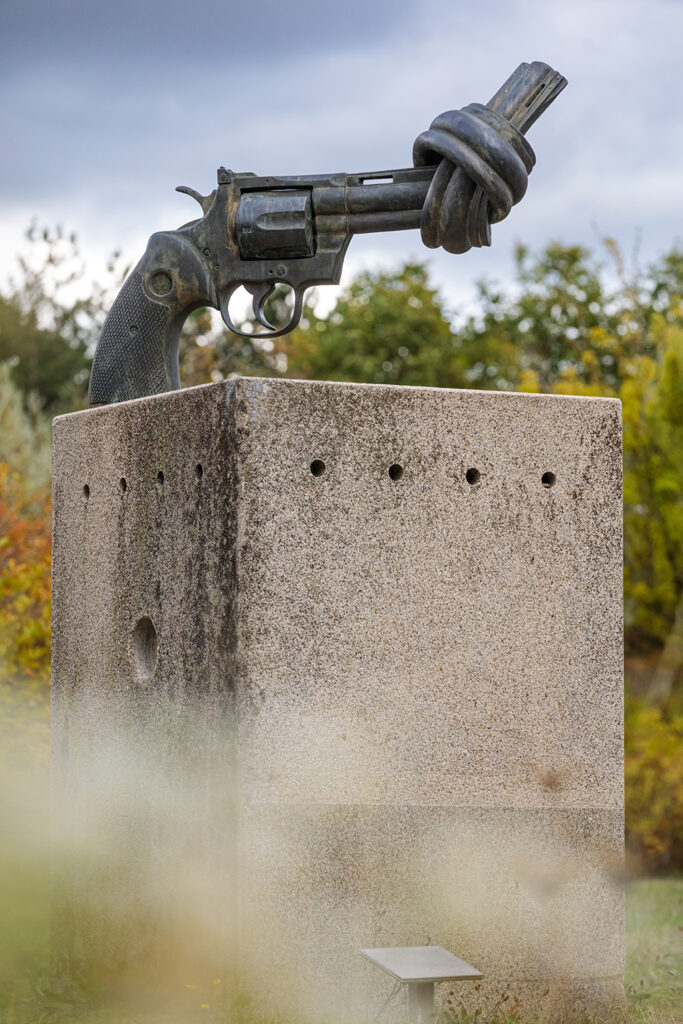When I was asked to choose an artwork, accessible to anyone in Luxemburg, one particular image immediately popped into my head; a statue entitled Non-Violence, a huge knotted bronze gun, 15 meters tall and 150 tons heavy. I was fascinated by the violence it exudes, and all my brain registered was a huge twisted gun standing in the middle of grey, featureless administrative buildings.
Carl Fredrik Reuterswärd, a Swedish painter and sculptor, produced this monument in 1980 as a tribute to his friend, John Lennon, after his assassination. The sculpture was initially placed across the street where Lennon and Yoko Ono lived. In 1988, the Luxembourgish government purchased one of the three originals and donated it to the United Nations, to place it in front of their headquarters in New York. The Luxembourgish government purchased another copy, which was installed in front of the European Commission. Since then, the institution has grown substantially, the building had to be extended and the “non-violence” statue had to move. It now stands in the central park of Luxembourg’s banking district. Maybe as an alibi for all the violence the neoliberal institutions around it are inflicting on the world? Like the artist’s compatriot, the Swedish weapons manufacturer Alfred Nobel, who invented a peace prize to deflect from the death and destruction his products are causing to this day.
During my research, I came across a petition calling for the sculpture in front of the UN headquarters to be removed, stating that it was hypocritical to use an image of a private weapon as a symbol against violence. Handguns aren’t the weapons our nations are using in their wars. Wouldn’t a monument against bioweapons, drones, neocolonial extractivism or colonial debts be more appropriate?
Thirty-one more copies of the sculpture have been purchased by institutions around the world and on theknottedgun.com you can buy a miniature version made from the metal of confiscated illegal weapons for about 10.000 U.S. dollars. There must be more to the enormous success of this artwork than just the need for a symbol. I came across an article by a pro-gun advocate, explaining that his main reason for having a weapon was not for safety, but because of his fascination for the object itself. Add this initial fascination1 to the violence of past crimes these miniature replicas contain and you clearly get a fetish object2.
Can an object that unwittingly evokes evil and power really become a symbol for peace and hope?3 How much force is needed to bend a seven-meter-long barrel into a knot? Once more, we are confronted with the male logic of responding to violence with violence, even if it’s done with the best of intentions. To me, all that this twisted barrel conveys is its own backfiring.
Instead, I invite you to read Ursula K. Le Guin’s essay The Carrier Bag Theory of Fiction, in which she convincingly illustrates that telling a gripping story about a day out in the fields gathering oat in a pouch is much harder than telling one about a hunt involving violence and weapons, but: “I’m not telling that story. We’ve heard it, we’ve all heard all about the sticks, spears and swords, the things to bash and poke and hit with, the long, hard things, but we have not heard about the thing to put things in, the container for the thing contained. That is a new story. That is news.”4
Now imagine holding a gun in your hand, even a twisted one. You hold it away from you, you feel the weight of the cold metal. You aim it at someone, and your gesture draws a hard line into the distance. How does that feel?
Then, imagine holding a bowl in both of your hands. You pass it to someone and you feel the weight of their warm hand. You offer something and your gesture becomes a circle. How does that feel? Like a much-needed new story perhaps?
Nora Wagner is an artist and an empirical researcher. She was born and raised in Luxembourg, studied Applied Arts in Montpellier, Fine Arts in Toulouse and recently finished her training as a “process-oriented nature therapist” in Berlin. Over the last ten years, she participated in and organised many collaborative and experimental cross-disciplinary art projects and is active in different artist collectives across Europe.
1 The etymology of the word “fascination” further supports my point: “When fascinate was first defined […] it was as ‘to bewitch or disfigure by enchantment’. This is unsurprising, as the word […] taken from the Latin fascinum (‘evil spell’), was entirely used in this manner.” https://tinyurl.com/99zypxna (last checked on: 03/10/2022).
2 “A fetish is an object believed to have supernatural powers or, in particular, a man-made object that has power over others. Essentially, fetishism is the attribution of inherent value or powers to an object. The word has strong colonialist and sexual connotations.” https://tinyurl.com/bdh594vj (last checked on: 03/10/2022).
3 https://tinyurl.com/2p95ffdf (last checked on: 03/10/2022).
4 https://tinyurl.com/5baszhn8 (last checked on: 03/10/2022).

Als partizipative Debattenzeitschrift und Diskussionsplattform, treten wir für den freien Zugang zu unseren Veröffentlichungen ein, sind jedoch als Verein ohne Gewinnzweck (ASBL) auf Unterstützung angewiesen.
Sie können uns auf direktem Wege eine kleine Spende über folgenden Code zukommen lassen, für größere Unterstützung, schauen Sie doch gerne in der passenden Rubrik vorbei. Wir freuen uns über Ihre Spende!
